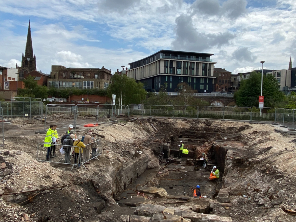
An archaeological dig at Rotherham’s Forge Island site has uncovered a treasure trove of ancient industrial artefacts.
Town centre developer Muse, along with partners from Rotherham Council and BWB Consulting teamed up with West Yorkshire Archaeological Services (WYAS), to take part in a dig on the Forge Island site, with residents and community groups invited on site to look at the findings.
Forge Island, which is currently being developed into a vibrant new leisure destination, has most recently been used as a car park and town centre supermarket. However, research shows the area has been well used over the years.
Created through the excavation of the Don Navigation in 1740 by 1753 the area had been made into a garden belonging to the Earl of Effingham – a current hereditary peerage in the UK that dates all the way back to 1510.
Industrial development began at the site in 1754 with the Walker & Co. Forge and a range of forges, mills, timber yards, a pub and even a row of terraced houses followed over the years.
The archaeological excavations focused on three areas. The first in the northern part of the site, where the terraced homes once stood, along with two further digs in the southern part of Forge Island, which was the location of the earliest forge.
On the northern dig, alongside the remains of external and internal walls and floor surfaces, were a range of 19th century artifacts, including pottery, glass, metal objects, a clay tobacco pipe, oyster shells and animal bone - all typical finds in excavations of homes of that era.
On the remaining two locations, as well as uncovering the remains of walls, furnaces, drainage, machine bases, metal tools, the extremely well-preserved remains of a water-wheel pit was found 5 meters below ground level.
Andrew Fairest, lead projects director at Muse, said: “It was incredibly interesting to uncover the past and find out more about what once stood at Forge Island. Residents and local community groups really enjoyed the sessions and some of the fantastic artifacts that were found.
“With any successful programme of regeneration, it’s vital to harness and celebrate an area’s rich history, then blend it seamlessly with its aspirations for the future. We firmly believe that our collective vision for Forge Island will demonstrate this and really deliver something special for the Rotherham community.”
Rotherham Council’s Cabinet Member for Jobs and the Local Economy, Cllr Denise Lelliott, said: “We’ve long known Rotherham has had a rich industrial background and wherever we build in the borough others have gone beforehand.
“With the changing times we are having to look at what Rotherham town centre needs to thrive and that means thinking differently and looking at how people will live in and use the town centre in years to come but it’s been fascinating to get a glimpse of the area’s past through these wonderful finds.”
Muse and the Council together are regenerating the Forge Island site and excitement is building ahead of the anticipated start on site in autumn this year. The team is transforming Forge Island into a vibrant family destination, with boutique cinema operator, The Arc, and Travelodge already signed up to anchor Forge Island, alongside a range of family orientated restaurants and bars.
The regenerated site will be set within an attractive public square with a new pedestrian bridge connecting the scheme to the wider town centre, alongside a riverside park with play equipment and planting designed to engage visitors upon their approach from the nearby public transport links.
Find out more about the plans for Forge Island and the town centre on the website: www.rotherhamtowncentre.co.uk
